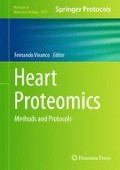Abstract
Differences in chromatin-associated proteins allow the same genome to participate in multiple cell types and to respond to an array of stimuli in any given cell. To understand the fundamental properties of chromatin and to reveal its cell- and/or stimulus-specific behaviors, quantitative proteomics is an essential technology. This chapter details the methods for fractionation and quantitative mass spectrometric analysis of chromatin from hearts or isolated adult myocytes, detailing some of the considerations for applications to understanding heart disease. The state-of-the-art methodology for data interpretation and integration through bioinformatics is reviewed.
Access this chapter
Tax calculation will be finalised at checkout
Purchases are for personal use only
References
Franklin S et al (2011) Specialized compartments of cardiac nuclei exhibit distinct proteomic anatomy. Mol Cell Proteomics 10:703
Franklin S et al (2012) Quantitative analysis of chromatin proteome reveals remodeling principles and identifies HMGB2 as a regulator of hypertrophic growth. Mol Cell Proteomics, 11: M111.014258
Lieberman-Aiden E et al (2009) Comprehensive mapping of long-range interactions reveals folding principles of the human genome. Science 326:289–293
van Steensel B, Dekker J (2010) Genomics tools for unraveling chromosome architecture. Nat Biotechnol 28:1089–1095
Kornberg RD (1974) Chromatin structure: a repeating unit of histones and DNA. Science 184:868–871
Zhang Z, Pugh BF (2011) High-resolution genome-wide mapping of the primary structure of chromatin. Cell 144:175–186
Rada-Iglesias A et al (2010) A unique chromatin signature uncovers early developmental enhancers in humans. Nature 470:279–283
Barski A et al (2007) High-resolution profiling of histone methylations in the human genome. Cell 129:823–837
Cuddapah S et al (2011) Genomic profiling of HMGN1 reveals an association with chromatin at regulatory regions. Mol Cell Biol 31:700–709
Schones DE, Zhao K (2008) Genome-wide approaches to studying chromatin modifications. Nat Rev Genet 9:179–191
Kouzarides T (2007) Chromatin modifications and their function. Cell 128:693–705
Schreiber SL, Bernstein BE (2002) Signaling network model of chromatin. Cell 111:771–778
Matouk CC, Marsden PA (2008) Epigenetic regulation of vascular endothelial gene expression. Circ Res 102:873–887
Ho L, Crabtree GR (2010) Chromatin remodeling during development. Nature 463:474–484
Haberland M, Montgomery RL, Olson EN (2009) The many roles of histone deacetylases in development and physiology: implications for disease and therapy. Nat Rev Genet 10:32–42
Narlikar GJ, Fan HY, Kingston RE (2002) Cooperation between complexes that regulate chromatin structure and transcription. Cell 108:475–487
Bai L, Santangelo TJ, Wang MD (2006) Single-molecule analysis of RNA polymerase transcription. Annu Rev Biophys Biomol Struct 35:343–360
Cairns BR (2009) The logic of chromatin architecture and remodelling at promoters. Nature 461:193–198
Heineke J, Molkentin JD (2006) Regulation of cardiac hypertrophy by intracellular signalling pathways. Nat Rev Mol Cell Biol 7:589–600
Rajabi M, Kassiotis C, Razeghi P, Taegtmeyer H (2007) Return to the fetal gene program protects the stressed heart: a strong hypothesis. Heart Fail Rev 12:331–343
Razeghi P et al (2001) Metabolic gene expression in fetal and failing human heart. Circulation 104:2923–2931
Louch WE, Sheehan KA, Wolska BM (2011) Methods in cardiomyocytes isolation, culture, and gene transfer. J Mol Cell Cardiol 51:288–298
Schluter KD, Schreiber D (2005) Adult ventricular cardiomyocytes: isolation and culture. Methods Mol Biol 290:305–314
O’Connell TD, Rodrigo MC, Simpson PC (2007) Isolation and culture of adult mouse cardiac myocytes. Methods Mol Biol 357:271–296
Nesvizhskii AI, Vitek O, Aebersold R (2007) Analysis and validation of proteomic data generated by tandem mass spectrometry. Nat Methods 4:787–797
Park SK, Venable JD, Xu T, Yates JR 3rd (2008) A quantitative analysis software tool for mass spectrometry-based proteomics. Nat Methods 5:319–322
Lomenick B et al (2009) Target identification using drug affinity responsive target stability (DARTS). Proc Natl Acad Sci USA 106:21984–21989
Kamleh A et al (2008) Metabolomic profiling using Orbitrap Fourier transform mass spectrometry with hydrophilic interaction chromatography: a method with wide applicability to analysis of biomolecules. Rapid Commun Mass Spectrom 22:1912–1918
Searle BC (2010) Scaffold: a bioinformatic tool for validating MS/MS-based proteomic studies. Proteomics 10:1265–1269
Acknowledgments
The Vondriska lab is supported by grants from the National Heart, Lung, and Blood Institute of the NIH and the Laubisch Endowment at UCLA. EM is recipient of the Jennifer S. Buchwald Graduate Fellowship in Physiology at UCLA, HC is the recipient of an American Heart Association Pre-doctoral Fellowship, and SF is the recipient of an NIH K99 Award.
Author information
Authors and Affiliations
Editor information
Editors and Affiliations
Rights and permissions
Copyright information
© 2013 Springer Science+Business Media New York
About this protocol
Cite this protocol
Chen, H., Monte, E., Vondriska, T.M., Franklin, S. (2013). Systems Proteomics of Healthy and Diseased Chromatin. In: Vivanco, F. (eds) Heart Proteomics. Methods in Molecular Biology, vol 1005. Humana Press, Totowa, NJ. https://doi.org/10.1007/978-1-62703-386-2_7
Download citation
DOI: https://doi.org/10.1007/978-1-62703-386-2_7
Published:
Publisher Name: Humana Press, Totowa, NJ
Print ISBN: 978-1-62703-385-5
Online ISBN: 978-1-62703-386-2
eBook Packages: Springer Protocols

